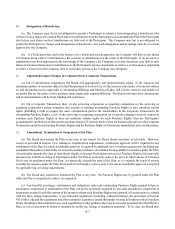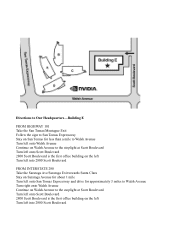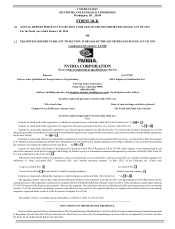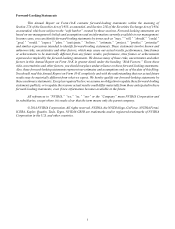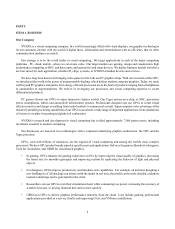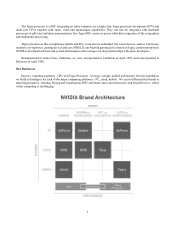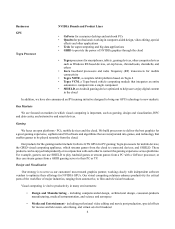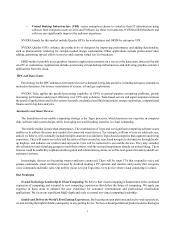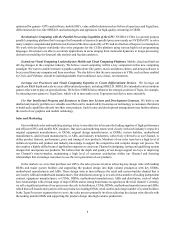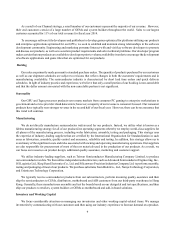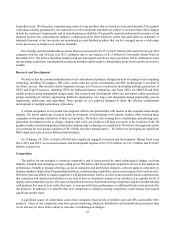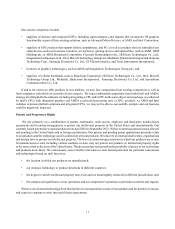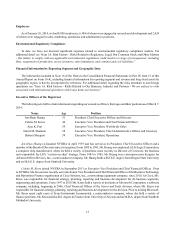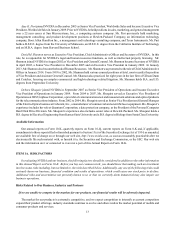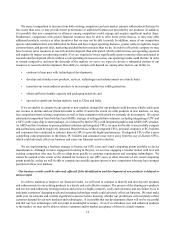NVIDIA 2013 Annual Report Download - page 148
Download and view the complete annual report
Please find page 148 of the 2013 NVIDIA annual report below. You can navigate through the pages in the report by either clicking on the pages listed below, or by using the keyword search tool below to find specific information within the annual report.4
PART I
ITEM 1. BUSINESS
Our Company
NVIDIA is a visual computing company. In a world increasingly filled with visual displays, our graphics technologies
let our customers interact with the world of digital ideas, information and entertainment with an efficiency that no other
communication medium can match.
Our strategy is to be the world leader in visual computing. We target applications in each of the major computing
platforms - PC, cloud, mobile - where we can create value. Our target markets are gaming, design and visualization, high
performance computing, or HPC, and data center, and automotive and smart devices. We deploy business models we believe
are best suited for each application, whether IP, chips, systems, or NVIDIA-branded devices and services.
We have long been known for bringing video games to life with our PC graphics chips. With our invention of the GPU,
we introduced the world to the power of programmable shading, which defines modern computer graphics. Today, we reach
well beyond PC graphics and games. Our energy-efficient processors are at the heart of products ranging from smartphones
to automobiles to supercomputers. We believe in leveraging our processors and visual computing expertise to create
differentiated products.
PC gamers choose our GPUs to enjoy immersive fantasy worlds. Our Tegra system-on-a-chip, or SOC, processors
power smartphones, tablets and automobile infotainment systems. Professional designers use our GPUs to create visual
effects in movies and design everything from audio headsets to commercial aircraft. Supercomputers take advantage of the
massively parallel processing capabilities of our GPUs to accelerate a wide range of important applications, from simulations
of viruses to weather forecasting and global oil exploration.
NVIDIA's research and development in visual computing has yielded approximately 7,000 patent assets, including
inventions essential to modern computing.
Our businesses are based on two technologies with a consistent underlying graphics architecture: the GPU and the
Tegra processor.
GPUs, each with billions of transistors, are the engines of visual computing and among the world's most complex
processors. We have GPU product brands aimed at specific users and applications: GeForce for gamers; Quadro for designers;
Tesla for researchers; and GRID for cloud-based graphics.
• In gaming, GPUs enhance the gaming experience on PCs by improving the visual quality of graphics, increasing
the frame rate for smoother gameplay and improving realism by replicating the behavior of light and physical
objects.
• For designers, GPUs improve productivity and introduce new capabilities. For example, an architect designing a
new building in a CAD package can interact with the model in real time, the model can be more detailed, and photo
realistic renderings can be generated for the client.
• Researchers can use GPUs to run their simulations faster while consuming less power, increasing the accuracy of
weather forecasts, or pricing financial derivatives more quickly.
• GRID uses GPUs to deliver graphics performance remotely, from the cloud. Uses include gaming, professional
applications provided as a service (SaaS) and improving Citrix and VMware installations.



